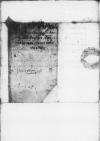Letter #2783
Bona Sforza to Ioannes DANTISCUSCracow, 154[6]-01-19
| received Heilsberg (Lidzbark Warmiński), 1546-02-01 Manuscript sources:
| ||||
Text & apparatus & commentaryPlain textText & commentaryText & apparatus
Reverendo in Christo Patri, domino
Reverende in Christo Pater, sincere nobis dilecte.
Tametsi paper damaged⌈[si]si paper damaged⌉ non habemus, quod Paternitati Vestrae scribamus, tamen servitorem eius ad illam redeuntem epistulam hanc sine ullo argumento ferre ad illam voluimus. Cui salutem et omnia fausta precamur, et pro eo officio, quod nos per litteras suas salutat crebro et novitates nobis scribit, magnas ei agimus et habemus gratias.
Quam salvam et felicem valere optamus.
Dat(ae) or Dat(um)⌈Dat(ae)Dat(ae) or Dat(um)⌉
Ex commissione propria s(acrae) or s(erenissimae)⌈s(acrae)s(acrae) or s(erenissimae)⌉ reginalis maiestatis


 BCz, 3465, p. 302
BCz, 3465, p. 302